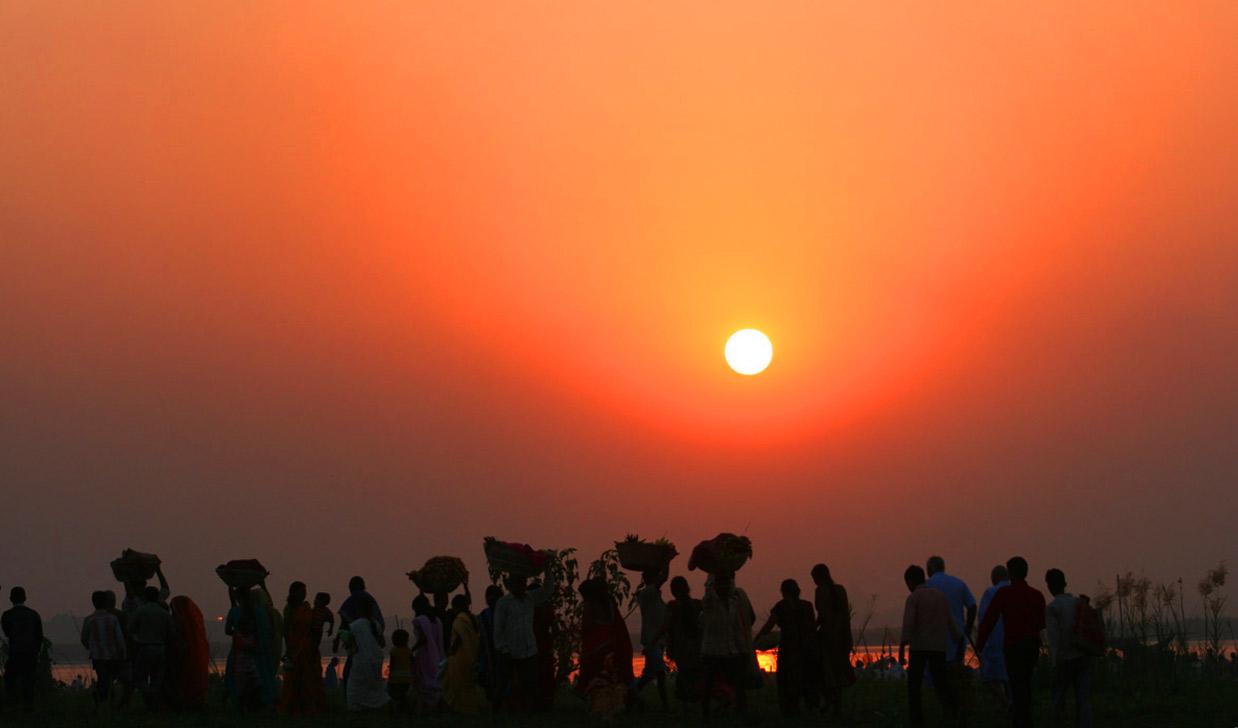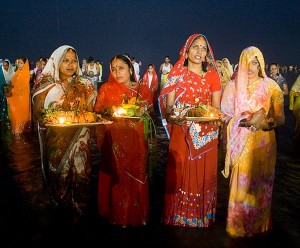
India Chhath Pooja (or Chatth Pooja) is one of the Indian festivals which is very popular in some parts of India but possibly not many people know in the other regions, hence this post is an attempt to make the people in those regions more aware about the significance of Chhat Pujan.
Chatth Pooja Festival
Basically the Chhat festival is a Vedic festival and not many of you may know that it is one of the oldest festivals of the country. This Indian festival is dedicated to Surya or the Sun Deity.
It is celebrated mostly in the North Indian states specifically in Bihar and Uttar Pradesh. Sun is symbolized in the ancient scriptures as the lord of prosperity and growth which is true in the natural sense also since if there was no sun there would be no life on earth.
This is why this festival is celebrated to thank the sun god for all the things that it has given us and also to request the deity to keep showering blessings on humanity. On this day the people pray for long life, prosperity and better health of their family and dear ones. Interestingly is is also celebrated in some parts of Nepal.
Chhath Pooja Dates 2017 and Schedule
Given below is the Chhat Pooja schedule for 2017 and below that is the detailed Chhat Pujan vidhi.
(Image Courtesy: Drikpanchang Site)
How is Chatth Pooja Carried Out?
Now let’s move on to how exactly it is celebrated. The celebration is a rigorous one and it spans over four days. It is celebrated either in October or November month every year. People fast for almost thirty six hours during this festival. This makes it one of the most difficult festivals in India. Considering the difficulties it is now a days not celebrated much by the younger generation. It is not as popular in urban India though there is no dearth of enthusiasm in the celebrations across rural areas, which obviously is still a majority in the nation.
Shakya Dwipi Brahmins
The mythological connections to this festivity are many. This puja was first done by the Shakya Dwipi Brahmins; this is why it is still celebrated in areas that are dominated by them.
Draupadi and Pandavas
This puja was also done by the Draupadi for Pandavas and also by Karna in Mahabharata.
Rig Veda
In the Rig Veda there is a detailed procedure mentioned on this festival. The rishis would follow this festival very closely. They would worship sun god and stop taking any external food stating that they will get the energy directly from the lord of Sun. They would fast for days and after doing the puja they would break the fast. Slowly it became a major festival for the common man as it is today.
Chhathi Maiya
The Goddess who is worshiped during this festival is called the Chhathi Maiya. She is known as Usha in the vedas. The ray of the sun is what Usha means in the Rig Veda. This ritual also finds a mention in this Veda. The ritual is such that whoever is doing this puja must stay away from all worldly pleasures for four continuous days. They should sleep on the floor that too on a single blanket and without pillow. They also fast during these days and some even don’t take water. This festival is mostly celebrated by women. However, many men too actively participate in the same.
A Related Story
There is an interesting story that is associated with it. The families who have been doing it must do it every year and also follow it for generations to come. If due to some reason someone skips this then a member of the family would die. Since it has been observed that many times this has turned out to be true, though we do not endorse or refute this theory and is just presented in the form of common belief amongst the masses. It is not possible that all members of the family keep it. However, at least one person must follow it.
Food Items
On the day of the puja the gods are offered kheer, thekua (this is a sweet that is made in every house during this festival) now a days it is also sold in shops, fruits and bamboos. The food that is cooked on the puja day for the worshipers to have is cooked without salt, onion and garlic. These substances are belived to spoil the purity of the food so are avoided.
NB: Please note that though the chart above shows 4 days, the routine below is of 5 days. This is because in some years two events fall on single day but the overall procedure is the same.
Day One of Chhath Pooja
On the first day of the puja, the worshipers wake up early in the morning. They dip in the holy Ganges. They then take some water home to make the offerings as described above. A heavy cleaning of the house is done for this puja.
The worshipers are allowed to eat only kaddu bhat, channa dal and non-boiled rice. This food is traditionally made in an earthen stove that is especially made for this purpose and mango wood is used. The cooking utensil should preferably be a bronze one. The worshiper must ensure that they never cook non veg items in this utensil again. In today’s world people do use steel utensils also.
Day Two of Chhath Pooja
On the day two of this festival, the worshipers fast for the whole day. They can break the fast a little before the sunset. Kheer, banana and puri is eaten mostly to break the fast. The kheer is made with jiggery no sugar is used. The same can be distributed among the family and friends. After this the worshiper goes on a thirty six hour long fast and that too without water.
Day Three of Chhath Pooja
On the day three of Chhath the worshiper spends most of the time at home making prasad. They can take help from people who are not fasting. However, the helpers must ensure that they have taken bath. The ingredients that are used must be pure and new. None of it must have been touched by a bird or animal of any kind. The worshiper takes these prasad or offering in the evening to a river bank or a pond. They throw the thekuas, fruits and milk to the sun by pouring them into the water. The worshiper must pronounce the Gayatri Mantra while doing this. She should dress like a bride.
The worshiper must wear a plain saree with a yellow border always. The Chhath song is sang in the back ground by the friends and families of the worshiper. On the night of this day, five sugarcane sticks are taken. They signify the five elements that the human body is made up of. These are the (earth, water, fire and ether). A lamp is lit on the head of these five bamboo sticks.
Day Four of Chhath Pooja
Now we move on to the final day of the Chhath pujan, the worshiper along with their family go to the river in the early morning. They offer their prayers and the offerings that they had been carrying with them. After this the fast is broken with an intake of prasad. The prasad is also given to friends and families. Even millionaires go to houses begging for the prasad. This is a symbolic gesture as an acceptance of the fact that all are beggars in front of the all mighty.
This is how these four days are celebrated with fasting, worshiping and rigorous hardships. The festival is still celebrated with the same enthusiasm as in the olden days. We hope this article will help you to understand the concept of Chhath Pooja festival better.


